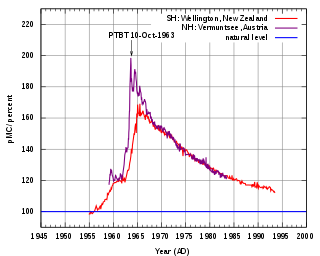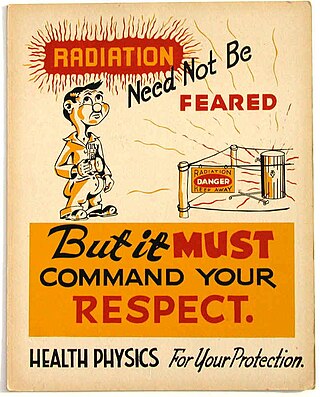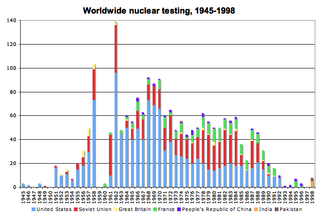
The United States Atomic Energy Commission (AEC) was an agency of the United States government established after World War II by the U.S. Congress to foster and control the peacetime development of atomic science and technology. President Harry S. Truman signed the McMahon/Atomic Energy Act on August 1, 1946, transferring the control of atomic energy from military to civilian hands, effective on January 1, 1947. This shift gave the members of the AEC complete control of the plants, laboratories, equipment, and personnel assembled during the war to produce the atomic bomb.

Nuclear fallout is residual radioactive material propelled into the upper atmosphere following a nuclear blast, so called because it "falls out" of the sky after the explosion and the shock wave has passed. It commonly refers to the radioactive dust and ash created when a nuclear weapon explodes. The amount and spread of fallout is a product of the size of the weapon and the altitude at which it is detonated. Fallout may get entrained with the products of a pyrocumulus cloud and when combined with precipitation falls as black rain, which occurred within 30–40 minutes of the atomic bombings of Hiroshima and Nagasaki. This radioactive dust, usually consisting of fission products mixed with bystanding atoms that are neutron-activated by exposure, is a form of radioactive contamination.

Nuclear technology is technology that involves the nuclear reactions of atomic nuclei. Among the notable nuclear technologies are nuclear reactors, nuclear medicine and nuclear weapons. It is also used, among other things, in smoke detectors and gun sights.

A mushroom cloud is a distinctive mushroom-shaped flammagenitus cloud of debris, smoke, and usually condensed water vapour resulting from a large explosion. The effect is most commonly associated with a nuclear explosion, but any sufficiently energetic detonation or deflagration will produce a similar effect. They can be caused by powerful conventional weapons, including thermobaric weapons such as the ATBIP and GBU-43/B MOAB. Some volcanic eruptions and impact events can produce natural mushroom clouds.

Operation Castle was a United States series of high-yield (high-energy) nuclear tests by Joint Task Force 7 (JTF-7) at Bikini Atoll beginning in March 1954. It followed Operation Upshot–Knothole and preceded Operation Teapot.

Castle Bravo was the first in a series of high-yield thermonuclear weapon design tests conducted by the United States at Bikini Atoll, Marshall Islands, as part of Operation Castle. Detonated on March 1, 1954, the device remains the most powerful nuclear device ever detonated by the United States and the first lithium deuteride-fueled thermonuclear weapon tested using the Teller-Ulam design. Castle Bravo's yield was 15 megatons of TNT [Mt] (63 PJ), 2.5 times the predicted 6 Mt (25 PJ), due to unforeseen additional reactions involving lithium-7, which led to radioactive contamination in the surrounding area.

"Duck and cover" is a method of personal protection against the effects of a nuclear explosion. Ducking and covering is useful in offering a degree of protection to personnel located outside the radius of the nuclear fireball but still within sufficient range of the nuclear explosion that standing upright and uncovered is likely to cause serious injury or death. In the most literal interpretation, the focus of the maneuver is primarily on protective actions one can take during the first few crucial seconds-to-minutes after the event, while the film of the same name and a full encompassing of the advice also cater to providing protection up to weeks after the event.

Daigo Fukuryū Maru was a Japanese tuna fishing boat with a crew of 23 men which was contaminated by nuclear fallout from the United States Castle Bravo thermonuclear weapon test at Bikini Atoll on March 1, 1954.

Radiophobia is an irrational or excessive fear of ionizing radiation, leading to overestimating the health risks of radiation compared to other risks. It can impede rational decision-making and contribute to counter-productive behavior and policies. Radiophobia is primarily a social phenomenon as opposed to a purely psychological dynamic. The term is also used to describe the opposition to the use of nuclear technology arising from concerns disproportionately greater than actual risks would merit.

Strontium-90 is a radioactive isotope of strontium produced by nuclear fission, with a half-life of 28.8 years. It undergoes β− decay into yttrium-90, with a decay energy of 0.546 MeV. Strontium-90 has applications in medicine and industry and is an isotope of concern in fallout from nuclear weapons, nuclear weapons testing, and nuclear accidents.

Underground nuclear testing is the test detonation of nuclear weapons that is performed underground. When the device being tested is buried at sufficient depth, the nuclear explosion may be contained, with no release of radioactive materials to the atmosphere.
A salted bomb is a nuclear weapon designed to function as a radiological weapon by producing larger quantities of radioactive fallout than unsalted nuclear arms. This fallout can render a large area uninhabitable. The term is derived both from the means of their manufacture, which involves the incorporation of additional elements to a standard atomic weapon, and from the expression "to salt the earth", meaning to render an area uninhabitable for generations. The idea originated with Hungarian-American physicist Leo Szilard, in February 1950. His intent was not to propose that such a weapon be built, but to show that nuclear weapon technology would soon reach the point where it could end human life on Earth.

A nuclear holocaust, also known as a nuclear apocalypse, nuclear annihilation, nuclear armageddon, or atomic holocaust, is a theoretical scenario where the mass detonation of nuclear weapons causes widespread destruction and radioactive fallout. Such a scenario envisages large parts of the Earth becoming uninhabitable due to the effects of nuclear warfare, potentially causing the collapse of civilization, the extinction of humanity, and/or the termination of most biological life on Earth.

The application of nuclear technology, both as a source of energy and as an instrument of war, has been controversial.
Project SUNSHINE was a series of research studies that began in 1953 to ascertain the impact of radioactive fallout on the world's population. The project was initially kept secret, and only became known publicly in 1956. Commissioned jointly by the United States Atomic Energy Commission and USAF Project Rand, SUNSHINE sought to examine the long-term effects of nuclear radiation on the biosphere due to repeated nuclear detonations of increasing yield. With the conclusion from Project GABRIEL that radioactive isotope Strontium-90 (Sr-90) represented the most serious threat to human health from nuclear fallout, Project SUNSHINE sought to measure the global dispersion of Sr-90 by measuring its concentration in the tissues and bones of the dead. Of particular interest was tissue from the young, whose developing bones have the highest propensity to accumulate Sr-90 and thus the highest susceptibility to radiation damage. SUNSHINE elicited a great deal of controversy when it was revealed that many of the remains sampled were utilized without prior permission from relatives of the dead, which wasn't known until many years later.

Louise Marie Zibold Reiss was an American physician who coordinated what became known as the Baby Tooth Survey, in which deciduous teeth from children living in the St. Louis, Missouri, area who were born in the 1950s and 1960s were collected and analyzed over a period of 12 years. The results of the survey showed that children born in 1963 had levels of strontium-90 in their teeth that were 50 times higher than those found in children born in 1950, before the advent of widespread nuclear weapons testing. The findings helped convince U.S. President John F. Kennedy to sign the Partial Nuclear Test Ban Treaty with the United Kingdom and Soviet Union, which ended the above-ground testing of nuclear weapons that placed the greatest amounts of nuclear fallout into the atmosphere.
The Baby Tooth Survey was initiated by the Greater St. Louis Citizens' Committee for Nuclear Information in conjunction with Saint Louis University and the Washington University School of Dental Medicine as a means of determining the effects of nuclear fallout in the human anatomy by examining the levels of radioactive material absorbed into the deciduous teeth of children.
Nicholas Monroe Smith Jr. was a nuclear physicist and research consultant. Smith was an expert on reactor physics, a developer of operations research/computer modeling, and a computer applications consultant. He had ties to the Manhattan Project at Chicago and Oak Ridge, and worked with Samuel Allison and James Van Allen. Smith was a pioneer in the field of operations research.

Dr Marshall Brucer (1913–1994) was an American medical researcher from Chicago, Illinois. He was appointed Chairman of the Medical Division of Oak Ridge Institute of Nuclear Studies in 1949, where he researched the applications of radiation in the treatment of cancer and other malignant diseases. He retired as Division chairman in 1962. A compendium of his writing entitled "A Chronology of Nuclear Medicine" was published by Robert R. Butaine in September 1990.

Charles Pecher was a Belgian pioneer in nuclear medicine. He discovered and introduced strontium-89 in medical therapeutic procedures in 1939.














